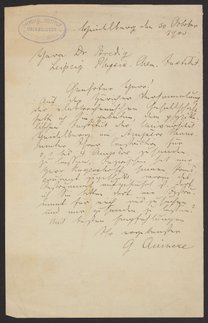Letter from Siegmund Gabriel to Georg Bredig
- 1891-Dec-09

Rights
Download all 2 images
PDFZIPof full-sized JPGsDownload selected image
Small JPG1200 x 768px — 158 KBLarge JPG2880 x 1842px — 837 KBFull-sized JPG4940 x 3160px — 2.2 MBOriginal fileTIFF — 4940 x 3160px — 44.7 MBSiegmund Gabriel (1851-1924), a German chemist, provides information on a salt compound to his colleague, Georg Bredig (1868-1944).
| Property | Value |
|---|---|
| Addressee | |
| Author | |
| Place of creation | |
| Format | |
| Genre | |
| Extent |
|
| Language | |
| Subject | |
| Rights | No Copyright - United States |
| Credit line |
|
| Additional credit |
|
| Digitization funder |
|
Institutional location
| Department | |
|---|---|
| Collection | |
| Series arrangement |
|
| Physical container |
|
View collection guide View in library catalog
Related Items
-
Letter from Svante Arrhenius to Georg Bredig, July 27, 19191919-Jul-27, 1919-Jul-31
Cite as
Gabriel, Siegmuund. “Letter from Siegmund Gabriel to Georg Bredig,” December 9, 1891. Papers of Georg and Max Bredig, Box 1, Folder 44. Science History Institute. Philadelphia. https://digital.sciencehistory.org/works/tdkx34g.
This citation is automatically generated and may contain errors.
Image 1
Berlin 9. Dezember 1891.
Sehr geehrter Herr Bredig!
Ich schicke Ihnen anbei einige Sachen betr. ein Salz, welche ich schließlich noch habe
auftreiben können, und bemerke dazu folgendes.
1. Das Bromethylaminbromkarbonat können Sie Ƒ bei 100° trocknen und können es ergänzt in eine Lösung von Nitrat verwandeln, wenn Sie die Lösung kalt + 1 Mal HNO3 dies schütteln und filtrieren.
2) Das Methylphenyloxazolin CH3.CH.O- dürfen Sie nur in kalter molinater CII2.n=C.C.II5 HCI (1 Mal) lösen; dampfen Sie diese Lösung wiederholt ein, so geht der Satz des Oxazolins in das Salz CH3.CH.O. (CII2 NII2) COC.II5 (HCI) über.
3) Die Lösung des Pyrrolidons in der äquivalenten Menge HCI werden Sie Ƒ naß über SO3, dann
Image 2
(page 2)
zwar wäßrig nicht kochen, da sonst vielleicht durch H2O-aufnahme HCI, NII2. CII2 CII2 CII2 COOH entstehen dürfte.
4) Das Pyrrolidin werden Sie wohl als Gleiches mit abwiegen können: Die Masse ist sehr flüchtig (Sdh. 88°). Sie werden sie daher direkt im Fluss schon + H2O verdünnen und dann in einer Schale + HCI eindampfen.
Indem ich die Verzögerung mit meiner Überlastung zu entschuldigen bitte, Ihnen viel Glück bei Ihren Arbeiten wünsche und Ihnen neun Wochen, 10 bis ich Sie sehe, in Aussicht stelle.
Bin ich mit besten Wünschen zum Jahre
Ihr dankbarer Gabriel.
Image 1
Berlin, December 9, 1891
Dear Mr. Bredig,
I am enclosing some information about a salt that I am finally able to find, and I would like to mention the following facts about it:
1. You can dry the bromoethylamine bromocarbonate Ƒ at 100° and turn it into a nitrate solution if you shake the solution when it cold, add HNO3, and filter it.
2) You may only dissolve the methylphenyloxazoline CH3.CH.O- in cold molinate CII2.n=C.C.II5 HCI (once); If you repeatedly evaporate this solution, the oxazoline compound changes into the salt CH3.CH.O. (CII2 NII2) COC.II5 (HCI).
3) Do not boil the pyrrolidone solution when it is wet or watery in the equivalent amount of HCI Ƒ over SO3.
Image 2
(page 2)
Otherwise, through the absorption of H2O, HCI, NII2. CII2 CII2 CII2 COOH could likely arise.
4) You will probably be able to weigh the pyrrolidine as well. The mass is very volatile (88°). Hence, you will dilute + H2O directly in the liquid and then evaporate them in a bowl + HCI.
I apologize for the delay on account of my workload and wish you all the best with your work. I look forward to seeing you in 9 or 10 weeks.
Best wishes for the end of the year.
Gratefully yours,
Gabriel






